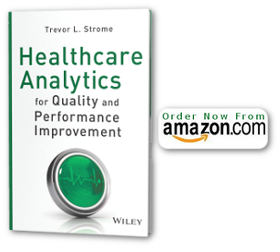The number of healthcare analytics options are increasing.
Some HCOs have the benefit of a large Business Intelligence (BI) or analytics platform. These stand-alone BI systems are somewhat general-purpose in nature, and operate in many industries other than healthcare. Many of these platforms are powerful indeed, with many analytics functions and features available.
In addition to the traditional BI platforms, there are some special-purpose healthcare analytics tools; these boutique tools tend to combine standard BI and analytics functionality with healthcare-specific context built-in.
Finally, there is a growing trend for Healthcare Information Technology (HIT) vendors to offer a set of analytics tools as part of, or in addition to, their main-stream” clinical systems such as electronic patient record (EPR) systems.
Success factors for healthcare improvement analytics
Despite what vender literature might claim, the ability to do meaningful analytics work that can truly impact healthcare improvement does not necessarily depend on having extensive (and expensive) analytic and business intelligence platforms.The critical factors for successfully applying analytics to healthcare improvement projects are:
- well defined and relevant performance indicators,
- timely performance data,
- appropriate analysis, and
- dissemination of results to pertinent stakeholders.
Note that these success factors do not depend on having large BI/analytics platforms available. A common phrase in Lean Transformation initiatives is “creativity over capital”. Healthcare improvement initiatives with the benefit of extensive technology support (i.e., big BI, flashy dashboards, etc) can still fail whereas initiatives with more “modest” but innovative analytics approaches and tools can be likely to succeed. The difference, of course, is not which analytic tools where utilized (and how expensive they were), but how they were utilized, how well analytics were integrated into the initiative, and whether the results were acted upon.
Note: The above article is a sample from our special report, Overcome Common Barriers to Effective Implementation of Healthcare Analytics, available for download in the resources section.

{ 0 comments… add one now }